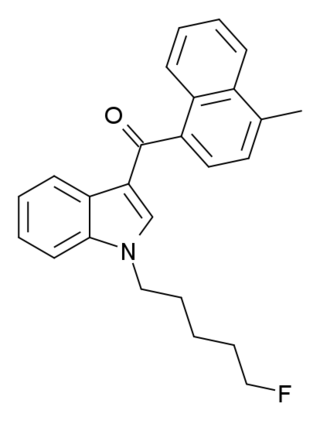
JWH-018 (1-pentyl-3-(1-naphthoyl)indole, NA-PIMO or AM-678) is an analgesic chemical from the naphthoylindole family that acts as a full agonist at both the CB1 and CB2 cannabinoid receptors, with some selectivity for CB2. It produces effects in animals similar to those of tetrahydrocannabinol (THC), a cannabinoid naturally present in cannabis, leading to its use in synthetic cannabis products that in some countries are sold legally as "incense blends".

U-50488 is a drug which acts as a highly selective κ-opioid agonist, but without any μ-opioid antagonist effects. It has analgesic, diuretic and antitussive effects, and reverses the memory impairment produced by anticholinergic drugs. U-50488 was one of the first selective kappa agonists invented and research on its derivatives has led to the development of a large family of related compounds. This compound has never received FDA approval and there are no reported human cases in the literature involving an U-50488 overdose.

AH-7921 is an opioid analgesic drug selective for the μ-opioid receptor, having around 90% the potency of morphine when administered orally. It was discovered in the 1970s by a team at Allen and Hanburys located in the United Kingdom. The drug is considered a new psychoactive substance (NPS) in which it is synthetically created in laboratories to mimic that of controlled substances. The substance has also been sold on the internet since 2012 as a "research chemical". When sold online it may be called the alternative name doxylam, not to be confused with doxylamine. AH-7921 has never progressed to clinical trials. The DEA is not aware of any medical usage in the United States, and has not insisted the Health and Human Services department (HHS) to conduct any medical research of the substance's uses.

MAM-2201 is a drug that presumably acts as a potent agonist for the cannabinoid receptors. It had never previously been reported in the scientific or patent literature, and was first identified by laboratories in the Netherlands and Germany in June 2011 as an ingredient in synthetic cannabis smoking blends. Like RCS-4 and AB-001, MAM-2201 thus appears to be a novel compound invented by "research chemical" suppliers specifically for grey-market recreational use. Structurally, MAM-2201 is a hybrid of two known cannabinoid compounds JWH-122 and AM-2201, both of which had previously been used as active ingredients in synthetic cannabis blends before being banned in many countries.

U-47700, also known as U4, pink heroin, pinky, and pink, is an opioid analgesic drug developed by a team at Upjohn in the 1970s which has around 7.5 times the potency of morphine in animal models.

Furanylfentanyl (Fu-F) is an opioid analgesic that is an analog of fentanyl and has been sold as a designer drug. It has an ED50 value of 0.02 mg/kg in mice. This makes it approximately one fifth as potent as fentanyl.

5F-APINACA is an indazole-based synthetic cannabinoid that has been sold online as a designer drug. Structurally it closely resembles cannabinoid compounds from patent WO 2003/035005 but with a 5-fluoropentyl chain on the indazole 1-position, and 5F-APINACA falls within the claims of this patent, as despite not being disclosed as an example, it is very similar to the corresponding pentanenitrile and 4-chlorobutyl compounds which are claimed as examples 3 and 4.

Bucinnazine is an opioid analgesic drug that was widely used in China to treat pain in cancer patients as of 1986. It is one of the most potent compounds among a series of piperazine-amides first synthesized and reported in Japan in the 1970s. Bucinnazine has analgesic potency comparable to that of morphine but with a relatively higher therapeutic index.

CUMYL-PEGACLONE (SGT-151) is a gamma-carboline based synthetic cannabinoid that has been sold as a designer drug. The gamma-carboline core structure seen in CUMYL-PEGACLONE had not previously been encountered in a designer cannabinoid, though it is similar in structure to other gamma-carboline cannabinoids disclosed by Bristol-Myers Squibb in 2001.

Metonitazene is an analgesic compound related to etonitazene, which was first reported in 1957, and has been shown to have approximately 1000 times the potency of morphine by central routes of administration, but if used orally it has been shown to have approximately 10 times the potency of morphine.

MDMB-4en-PINACA is an indazole-based synthetic cannabinoid that has been sold online as a designer drug. MDMB-4en-PINACA was first identified in Europe in 2017. In 2021, MDMB-4en-PINACA was the most common synthetic cannabinoid identified by the Drug Enforcement Administration in the United States. MDMB-4en-PINACA differs from 5F-MDMB-PINACA due to replacement of 5-fluoropentyl with a pent-4-ene moiety (4-en).

Etonitazepyne is a benzimidazole derivative with potent opioid effects which has been sold over the internet as a designer drug and linked to numerous cases of overdose.

ADB-4en-PINACA is a cannabinoid designer drug that has been found as an ingredient in some synthetic cannabis products, first appearing in early 2021. It is a reasonably potent cannabinoid agonist in vitro but has not been so widely sold as related compounds such as ADB-PINACA and MDMB-4en-PINACA.

Butyrnorfentanyl or butyrylnorfentanyl is an inactive synthetic opioid analgesic drug precursor. It is an analog of fentanyl.

Protonitazene is a benzimidazole derivative with potent opioid effects which has been sold over the internet as a designer drug since 2019, and has been identified in various European countries, as well as Canada, the USA and Australia. It has been linked to numerous cases of drug overdose, and is a Schedule I drug in the USA.

N-Desethylisotonitazene (Norisotonitazene) is a benzimidazole derivative with potent opioid effects which has been sold as a designer drug. It was first identified as an active metabolite of the related compound isotonitazene, but was unexpectedly found to be similar potency compared to the parent compound, and is among the most potent opioid agonists in this family, around 20 times stronger than fentanyl. It has become an increasingly widespread drug of abuse in its own right, linked to numerous cases of drug overdose,and may be considered an analog of a schedule 1 drug in the US. On October 25 an intent to temporarily schedule Etonitazepipne and N-desethyl Isotonitazene was published. So on November 24 a month after publishing intent, it will most likely be placed in schedule 1.

3,4-MDO-U-47700 is an opioid analgesic which has been sold as a designer drug, first appearing in 2017 after U-47700 itself was banned in various jurisdictions. It is less potent than U-47700 but is still a full agonist at the μ-opioid receptor, with slightly higher potency than morphine. It is illegal in Virginia.
Utopioids are a class of synthetic opioid analgesic drugs first developed in the 1970s by the pharmaceutical company Upjohn. However, they were never marketed for medical use. Some compounds from this class have been used for scientific research as model kappa opioid receptor agonists. In the mid-2010s, one mu opioid receptor selective compound from this class, U-47700, re-emerged as a designer drug and became widely sold around the world for several years before being banned in various jurisdictions from 2016 onwards. Following the prohibition of U-47700, a number of related compounds have continued to appear on illicit drug markets. They are often marketed online or included as components in mixtures sold under the guise of "street heroin." U-47700 itself is the most potent mu opioid agonist from this class, around 7-10x the potency of morphine. Some other compounds such as 3,4-MDO-U-47700 and N-Ethyl-U-47700 retain similar mu selectivity but with lower potency similar to that of morphine, or have a mixture of mu and kappa mediated effects, such as U-48800. Most utopioid derivatives are however selective kappa agonists, which may have limited abuse potential as dissociative hallucinogens, but do not alleviate withdrawal distress in opioid dependent individuals or maintain addiction in a typical sense. Nevertheless, this has not stopped them from being sold as designer drugs, and a number of these compounds are now banned in many jurisdictions alongside U-47700 itself.

















